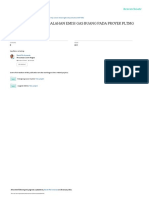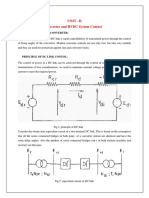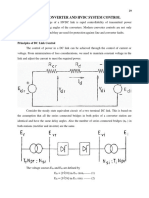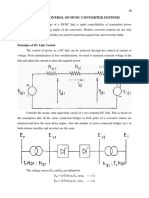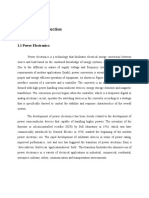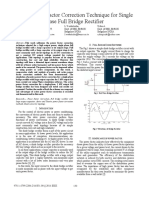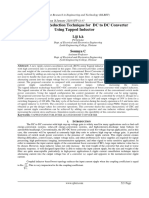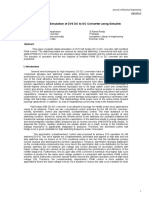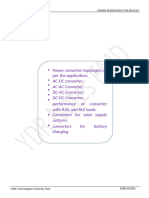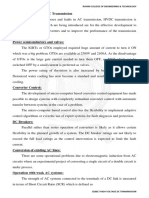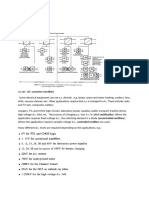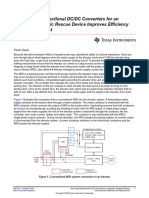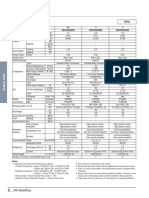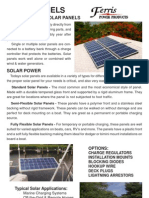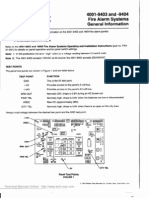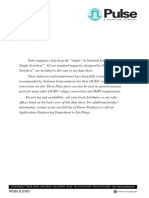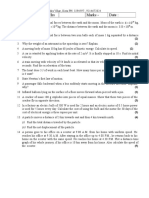Control Characteristics
Control Characteristics
Uploaded by
Ayesha FirdausCopyright:
Available Formats
Control Characteristics
Control Characteristics
Uploaded by
Ayesha FirdausOriginal Title
Copyright
Available Formats
Share this document
Did you find this document useful?
Is this content inappropriate?
Copyright:
Available Formats
Control Characteristics
Control Characteristics
Uploaded by
Ayesha FirdausCopyright:
Available Formats
ROHINI COLLEGE OF ENGINEERING & TECHNOLOGY
3.2 Converter control characteristics
Basic Characteristics:
The intersection of the two characteristics (point A) determines the mode of
operation-Station I operating as rectifier with constant current control and station II
operating at constant (minimum) extinction angle.
There can be three modes of operation of the link (for the same direction of power
flow) depending on the ceiling voltage of the rectifier which determines the point of
intersection of the two characteristics which are defined below
1) CC at rectifier and CEA at inverter (operating point A) which is the normal mode
of operation.
2) With slight dip in the AC voltage, the point of intersection drifts to C which implies
minimum α at rectifier and minimum γ at the inverter.
3) With lower AC voltage at the rectifier, the mode of operation shifts to point B
which implies CC at the inverter with minimum α at the rectifier.
Figure 3.2.1 Converter control characteristics
[Source: “HVDC Power Transmission Systems” by K.P.Padiyar, page-87]
The characteristic AB has generally more negative slope than characteristic FE
because the slope of AB is due to the combined resistance of (R d + Rcr ) while is the slope
of FE is due to Rci .
EE8017 HIGH VOLTAGE DC TRANSMISSION
ROHINI COLLEGE OF ENGINEERING & TECHNOLOGY
Figure 3.2.2 Converter control characteristics for negative current margin
[Source: “HVDC Power Transmission Systems” by K.P.Padiyar, page-87]
The above figure shows the control characteristics for negative current margin I m
(or where the current reference of station II is larger than that of station I). The operating
point shifts now to D which implies power reversal with station I (now acting as inverter)
operating with minimum CEA control while station II operating with CC control.
This shows the importance of maintaining the correct sign of the current margin to
avoid inadvertent power reversal. The maintenance of proper current margin requires
adequate telecommunication channel for rapid transmission of the current or power order.
Voltage Dependent Current Limit:
The low voltage in the DC link is mainly due to the faults in the AC system on the
rectifier or inverter side. The low AC voltage due to faults on the inverter side can result
in persistent commutation failure because of the increase of the overlap angle. In such
cases, it is necessary to reduce the DC current in the link until the conditions that led to
the reduced DC voltage are relieved. Also the reduction of current relieves those valves
in the inverter which are overstressed due to continuous current flow in them.
Figure 3.2.3 Converter control characteristics including VDCOL
[Source: “HVDC Power Transmission Systems” by K.P.Padiyar, page-84]
EE8017 HIGH VOLTAGE DC TRANSMISSION
ROHINI COLLEGE OF ENGINEERING & TECHNOLOGY
If the low voltage is due to faults on the rectifier side AC system, the inverter has
to operate at very low power factor causing excessive consumption of reactive power
which is also undesirable. Thus, it becomes useful to modify the control characteristics
to include voltage dependent current limits. The figure above shown shows current error
characteristics to stabilize the mode when operating with DC current between I d1 and Id2.
The characteristic cc| and c|c|| show the limitation of current due to the reduction in
voltage.
EE8017 HIGH VOLTAGE DC TRANSMISSION
You might also like
- Comparison Between LCC and VSCDocument5 pagesComparison Between LCC and VSCijsretNo ratings yet
- Kajian Teknis Permasalahan Emisi Gas Buang Pada Proyek PLTMG Luwuk 40 MWDocument14 pagesKajian Teknis Permasalahan Emisi Gas Buang Pada Proyek PLTMG Luwuk 40 MWWilliam Mikhael P100% (1)
- Unit-2-Converter and HVDC System ControlDocument14 pagesUnit-2-Converter and HVDC System ControlT shivaprasad100% (1)
- Unit-2-Converter and HVDC System ControlDocument13 pagesUnit-2-Converter and HVDC System Controlravikumar_ranganNo ratings yet
- Unit-Ii: Converter and HVDC System Control: Principles of DC Link ControlDocument22 pagesUnit-Ii: Converter and HVDC System Control: Principles of DC Link ControlMr. R. Jagan EEENo ratings yet
- Unit-2 Part ADocument16 pagesUnit-2 Part AMr. R. Jagan EEENo ratings yet
- BE EE 8sem-Converter Sys Control-Neha SinghDocument16 pagesBE EE 8sem-Converter Sys Control-Neha SinghPritesh PandyaNo ratings yet
- HVDC Unit IIIDocument22 pagesHVDC Unit IIISreenivas Reddy BodimallaNo ratings yet
- Control of HVDC Converter StationsDocument14 pagesControl of HVDC Converter Stationssrinivas pNo ratings yet
- Fundamentals of HVDC & Facts Devices: Unit - IiDocument13 pagesFundamentals of HVDC & Facts Devices: Unit - Iinarendra kumarNo ratings yet
- Control of HVDCDocument38 pagesControl of HVDCPrasanna Kumar100% (2)
- Chapter-1 Introduction: 1.1 Power ElectronicsDocument8 pagesChapter-1 Introduction: 1.1 Power ElectronicsSatya SahityasekharNo ratings yet
- Professor MD Dutt: Reading Material For B.E. Students of RGPV Affiliated Engineering CollegesDocument20 pagesProfessor MD Dutt: Reading Material For B.E. Students of RGPV Affiliated Engineering CollegesMary MorseNo ratings yet
- Converter Control CharacteristicsDocument57 pagesConverter Control Characteristicssrinivas pNo ratings yet
- Unit 4Document15 pagesUnit 4prashantpnd07100% (2)
- Active Power Factor Correction Technique For Single Phase Full Bridge RectifierDocument6 pagesActive Power Factor Correction Technique For Single Phase Full Bridge RectifierAnand KumarNo ratings yet
- Four QuadrantDocument45 pagesFour QuadrantAnonymous L96u5it0% (1)
- Analysis of Different Topologies For Active Power Factor CorrectionDocument8 pagesAnalysis of Different Topologies For Active Power Factor Correctionnnpatel1990No ratings yet
- TWO Power Conversion Systems 2.1 Power Electronic ConvertersDocument17 pagesTWO Power Conversion Systems 2.1 Power Electronic ConvertersAlhussain EmbarkNo ratings yet
- 19 Jay PrakashDocument6 pages19 Jay Prakashhimanshupatlan191No ratings yet
- Transformer Based Resonant DC Inverter For Brushless DC Motor Drive SystemDocument7 pagesTransformer Based Resonant DC Inverter For Brushless DC Motor Drive SystemStudents Xerox ChidambaramNo ratings yet
- Modelling Bidirectional Buck BoostDocument7 pagesModelling Bidirectional Buck BoostAkay HanafiahNo ratings yet
- Angle Controlled Current Regulated Rectifiers For AC/AC ConvertersDocument7 pagesAngle Controlled Current Regulated Rectifiers For AC/AC ConvertersKanomba JavaNo ratings yet
- Ripple Current Reduction Technique For DC To DC Converter Using Tapped InductorDocument6 pagesRipple Current Reduction Technique For DC To DC Converter Using Tapped InductorInternational Journal of Latest Research in Engineering and TechnologyNo ratings yet
- Basic Electronics Unit 2Document20 pagesBasic Electronics Unit 2thippalururanjithNo ratings yet
- Digital Simulation of ZVS DC To DC Converter Using Simulink: AbstractDocument13 pagesDigital Simulation of ZVS DC To DC Converter Using Simulink: AbstractjimmyNo ratings yet
- A Comparative Evaluation of Isolated Bi-Directional DC - DC Converters With Wide Input and Output Voltage RangeDocument8 pagesA Comparative Evaluation of Isolated Bi-Directional DC - DC Converters With Wide Input and Output Voltage RangePhạm Văn TưởngNo ratings yet
- Lab 2 Buck ConverterDocument3 pagesLab 2 Buck ConverterShah VinodNo ratings yet
- 2.1 Chapter 2 (BRB)Document3 pages2.1 Chapter 2 (BRB)Anil Kumar SinghNo ratings yet
- Power ConvertersDocument22 pagesPower Convertersdaryappamane98No ratings yet
- Comparison of AC and DC TransmissionDocument4 pagesComparison of AC and DC TransmissionPayal meenaNo ratings yet
- Ac DC PWMDocument6 pagesAc DC PWMIrfan AliNo ratings yet
- Rohini 96369866524Document2 pagesRohini 96369866524kamleshpandya1965No ratings yet
- A Review On Single Phase To Three Phase Power Converters: Kaushal W. Kakad & Nitin R. BhasmeDocument10 pagesA Review On Single Phase To Three Phase Power Converters: Kaushal W. Kakad & Nitin R. BhasmeTJPRC PublicationsNo ratings yet
- A New Single-Phase Single-Stage Three-Level Power Factor Correction AC-DC ConverterDocument12 pagesA New Single-Phase Single-Stage Three-Level Power Factor Correction AC-DC Convertersurya_v988No ratings yet
- A Novel Modeling and Control Method For Three-Phase ConvertersDocument6 pagesA Novel Modeling and Control Method For Three-Phase Convertersdhirajbharat20No ratings yet
- Study of AC and-WPS OfficeDocument6 pagesStudy of AC and-WPS OfficeBeena PalNo ratings yet
- BuckConverter Design Jpe10Document13 pagesBuckConverter Design Jpe10joviflocasNo ratings yet
- HVDC Unit IIIDocument13 pagesHVDC Unit IIIs.suresh k.swaminathanNo ratings yet
- A Novel Switch Mode DC-AC Inverter With Nonlinear Robust Control (IEEE-TIE)Document7 pagesA Novel Switch Mode DC-AC Inverter With Nonlinear Robust Control (IEEE-TIE)Al Bajad MamadNo ratings yet
- Bi-Dirctional Acdc Converter Based On Neutral Point ClampedDocument6 pagesBi-Dirctional Acdc Converter Based On Neutral Point ClampedphieuxuatkhoNo ratings yet
- Be 6TH Sem SMPS Pe Garima SolankiDocument10 pagesBe 6TH Sem SMPS Pe Garima SolankiSadegh ShebaniNo ratings yet
- Flyback ConverterDocument5 pagesFlyback ConverterAlin PopescuNo ratings yet
- PWM Rectifier Design Lab ReportDocument12 pagesPWM Rectifier Design Lab ReportSarika ChauhanNo ratings yet
- HVDC Transmission Unit-3Document38 pagesHVDC Transmission Unit-3Narendra KNo ratings yet
- First Quadrant Single Phase Ac To DC Converter Semiconverter Separately Excited DC MotorDocument9 pagesFirst Quadrant Single Phase Ac To DC Converter Semiconverter Separately Excited DC MotorzaidNo ratings yet
- 3 HVDC Converter Control PDFDocument78 pages3 HVDC Converter Control PDFJanaki BonigalaNo ratings yet
- Simulation Current Controlled: Converter-InverterDocument5 pagesSimulation Current Controlled: Converter-InverterVivek VickyNo ratings yet
- An3166 PDFDocument10 pagesAn3166 PDFJonathan JaegerNo ratings yet
- Modeling and Simulation of Bidirectional Ac-Dc Power ConverterDocument4 pagesModeling and Simulation of Bidirectional Ac-Dc Power ConverterKalyan Reddy AnuguNo ratings yet
- Chap 3Document28 pagesChap 3Adem AbdelaNo ratings yet
- Bi-Directional DC-to-DC Converter For Solar Applications With Battery BackupDocument5 pagesBi-Directional DC-to-DC Converter For Solar Applications With Battery BackupPaulius BruneikaNo ratings yet
- Design & Simulation of Single Phase PWM Rectifier With IEEE 519 ComplianceDocument6 pagesDesign & Simulation of Single Phase PWM Rectifier With IEEE 519 CompliancepauloNo ratings yet
- Veas 1994Document7 pagesVeas 1994martin.teruelNo ratings yet
- Simulation and Prototype Implementation of Phase Shift Full Bridge DC DC ConverterDocument4 pagesSimulation and Prototype Implementation of Phase Shift Full Bridge DC DC ConverterjimmyNo ratings yet
- LCC HVDCDocument7 pagesLCC HVDCSubbu ChNo ratings yet
- Application of DC/DC Buck Power Converter in DC Motor For Speed Controlling Using PI ControllerDocument5 pagesApplication of DC/DC Buck Power Converter in DC Motor For Speed Controlling Using PI ControllerShreeji ExportsNo ratings yet
- sszt421Document5 pagessszt421Mouloud IbelaidenNo ratings yet
- Reference Guide To Useful Electronic Circuits And Circuit Design Techniques - Part 2From EverandReference Guide To Useful Electronic Circuits And Circuit Design Techniques - Part 2No ratings yet
- Power Systems-On-Chip: Practical Aspects of DesignFrom EverandPower Systems-On-Chip: Practical Aspects of DesignBruno AllardNo ratings yet
- Indiragandhi Sports Complex, Indraprastha EstateDocument31 pagesIndiragandhi Sports Complex, Indraprastha Estatethesis99 final yearNo ratings yet
- Class-11 Annual Paper (RETEST) and Solution (Physics)Document18 pagesClass-11 Annual Paper (RETEST) and Solution (Physics)singhamritansha670No ratings yet
- Specifications: N Cooling OnlyDocument4 pagesSpecifications: N Cooling OnlyGABRIELA ALEXANDRA GAITAN TUSELLNo ratings yet
- التجربة 14Document4 pagesالتجربة 14ali0abas137No ratings yet
- Fuel Cycles: Prepared by Mukesh Tayal and Milan Gacesa - Independent ConsultantsDocument56 pagesFuel Cycles: Prepared by Mukesh Tayal and Milan Gacesa - Independent ConsultantselsayedNo ratings yet
- Rotational Inertia: Ma T MG FDocument8 pagesRotational Inertia: Ma T MG FharpreetNo ratings yet
- Assignment Week 5 PDFDocument3 pagesAssignment Week 5 PDFMD AJMALNo ratings yet
- MP 12 TGDocument5 pagesMP 12 TGأبو زينب المهندسNo ratings yet
- The GoBiGas Project - Demonstration of The Production of Biomethane From Biomass V 230507 - 6 - 0Document101 pagesThe GoBiGas Project - Demonstration of The Production of Biomethane From Biomass V 230507 - 6 - 0samroozbehaniNo ratings yet
- 22 29.pdf SolarDocument8 pages22 29.pdf SolarAbdul Yekini AhmaduNo ratings yet
- IGCSE Grade 6 PhysicsDocument5 pagesIGCSE Grade 6 PhysicsSathya Marie100% (1)
- Ug Physics On 16Document59 pagesUg Physics On 16Ruban PravinNo ratings yet
- SHEET4 AnswersDocument20 pagesSHEET4 AnswersHamadaMohassabNo ratings yet
- Diesel Power PlantDocument28 pagesDiesel Power PlantHassan MalghaniNo ratings yet
- Automatic Contingency SelectionDocument13 pagesAutomatic Contingency SelectionGerman Silva100% (1)
- 4001 9403 9404+General+InformationDocument4 pages4001 9403 9404+General+InformationI Made BambangNo ratings yet
- Ust Shape ReviewerDocument28 pagesUst Shape ReviewerkNo ratings yet
- Wind Turbine Generators: © P. KundurDocument24 pagesWind Turbine Generators: © P. Kunduravillanueva_1No ratings yet
- Printed On Recycled PaperDocument11 pagesPrinted On Recycled PaperVictor SampaNo ratings yet
- Kcn463hag BXXXDocument4 pagesKcn463hag BXXXPawan SehrawatNo ratings yet
- D1.2 - Report On RDF-SRF Utilization Applications and Technical SpecificationsDocument30 pagesD1.2 - Report On RDF-SRF Utilization Applications and Technical Specificationsedin šerifovicćNo ratings yet
- HT33-TX Series Tower Online UPS: 10-40kVA (380V/400V/415V)Document1 pageHT33-TX Series Tower Online UPS: 10-40kVA (380V/400V/415V)dhaferNo ratings yet
- EEEM61 - 3rd Unit NotesDocument16 pagesEEEM61 - 3rd Unit NotesSuryaNo ratings yet
- Calisto CalibrationDocument8 pagesCalisto CalibrationPrasad MhatreNo ratings yet
- Question Bank For 9 TH ClassDocument20 pagesQuestion Bank For 9 TH ClassVaibhav TripathiNo ratings yet
- QTN For 60 HP MachineDocument4 pagesQTN For 60 HP Machineheavenrocks upadhyayNo ratings yet
- Modelling of Power System Component PDFDocument37 pagesModelling of Power System Component PDFSandeepKumarNo ratings yet
- Energies: A Comprehensive Review of The Bidirectional Converter Topologies For The Vehicle-to-Grid SystemDocument33 pagesEnergies: A Comprehensive Review of The Bidirectional Converter Topologies For The Vehicle-to-Grid SystemRamshaNo ratings yet
- Physics ProbSet 4Document2 pagesPhysics ProbSet 4macrohon016No ratings yet

